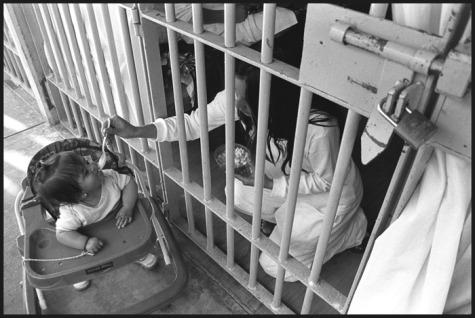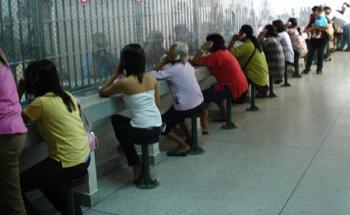Serendip is an independent site partnering with faculty at multiple colleges and universities around the world. Happy exploring!
Owl's blog

Funding for Literacy
Image retrieved from: http://www.educationnews.org/technology/raygunreports-com-aims-to-save-students-money-on-textbooks/
In chapter two of Reading is my Window, Sweeney states: “In Ohio Prisons, the general libraries are funded entirely by revenue from each prison’s vending machines and commissary...” (57). The lack of funding for prison libraries is extremely outrageous, but what is even more outrageous is how much of the funding, going into prison programs that help alleviate recidivism. is “entirely” dependent on the prisoners themselves who have little to no resources and/or opportunities to earn wages. How can we expect prison libraries to have good reading material, or any at all, if the monetary resources are not available?

Motherhood and Incarceration

Ideas of motherhood are often tools that incarcerated mothers use to help them survive imprisonment, but, they fail to realize just how many barriers are imposed on them that inhibit their ability to be mothers once they are released.

Prison and School Across Music, Television, and more
http://www.youtube.com/watch?v=v7gV5C5mB7A
http://www.youtube.com/watch?v=OG3ieifrqyQ
http://www.youtube.com/watch?v=Sw9DADUh490
http://www.youtube.com/watch?v=sBg7AqXRwqg
http://www.youtube.com/watch?v=kR2wfLyT-b0&feature=related
http://www.youtube.com/watch?v=1GZZ13rJsus
http://www.youtube.com/watch?v=Mb1ZvUDvLDY
This is my high school. To give you a picture of how many kids were housed in this school here is following statistic: My graduating class was over 500 students. This does not include students who didn't quite make the cut and all the rest of the school population.

Visiting hours in prison.


Keepers of Silence
After reading only the first page of Brothers and Keepers I could already see how silence and voice found common ground--as described in Yves-Charles Grandjeat's article--in Wideman's ability to speak to his brother in the form of letters. The distance and silence between Wideman and his brother allowed him to be hopeful that his brother might reunite with him despite the space, time, and unknowingness that existed between them-the silence. In this case voice was the unwillingness to get caught up in the "sense of urgency, of inpending disaster..." (pg5) that was plaguing those in close physical proximity to his brother's crime. This really makes me wonder about our definitions of voice and how more often than not we refer to voice in our class as the literal ability to speak out and the limitations that prevent people to do so due to race, gender, and/or class. I think that another way to understand voice is to look at it as choice: having the choice to create silence is also voice. Wideman chose to move away from home and in this action dilIberately created space and silence between him, his brother, and his family. However, it is crucial here to understand how silence as voice can also be a used as a silencing tool. For example, lately in our class, we have been discussing how choosing silence allows others to speak. I am not opposed to the sentiment behind this, however, I do realize another effect that choosing silence can have on the class in its entirety.

Pre-conceived Notions
One of the biggest issues I have with the dependency discourse is that it disproportionately effects women both in and out of prison. As we can see in Offending Women and its description of the Alliance program, the dependency discourse seemed to dominate both how the institution itself formulated their political and istitutional needs as well as how the program constructed their goals. It makes me wonder how much of what we want and need for incarcerated women is already pre-determined by the way in which we label and categorize them before they become incarcerated. It is not a mystery that most incarcerated people are of poverty stricken backgrounds and that they are usually non-white. But, as the numbers have shown, it is also true that poor women of color are getting incarcerated at higher rates than any other population. I think that in order to understand incarceration of poor women of color and thus, how education within the walls of the institutions affect them, we must also understand how they are seen in greater society. This brings me to the issue of Welfare. Many poor women of color are on welfare before they even become incarcerated. The term welfare in it of itself assumes that there is, in a heirarchical sense, a give and take relationship between those on welfare and those distributing it. It makes women out to look like leeches.

Second Essay for Silence Class
Hey 360 friends. I am writing to let you know that my second web event for our silence class is posted as a comment to my first essay.I was not able to tag my comment as a web event and so I am linking you to my first essay here so that you can easily find my new web event.

The Healing Walls, Incarceration, and E.S.P
As we stopped to visit the healing walls on the mural tour yesterday, I was surprised by my reaction to the offender wall. I think it was the combination of the music coming from the community service event across the street and the large exposed grass area in front of the mural that somehow made it much more appealing to me. The mural itself was more exposed than the victim mural and I felt a rush of sadness come over me as I took the time to understand the color scheme in the mural. I think the thing that I found myself really focusing on was the distant memories of families that were painted on the far bottom left corner. When most people think about offenders, they are are overwhelmed by images of their crime and thier feelings of vengence that they forget about the families they leave behind, and how much of the consequence and effect of committing a crime is really seen in the families of the offenders. As a society we focus on the victims of crime and neglect the offender, by which I mean we focus on helping the victims heal by attaching negative attention to offenders. But, as we have seen in our vision class, the definiton of victim becomes really obscure when we add the social context out of which both victims and offenders come from. When a member of a community is incarcerated that community including the family becomes more and more disenfranchised.

Policing Education
In Greg Dimitriadis' "Popular Culture, Pedagogy, and Urban Youth: Beyond Silenced Volices" I was intrigued his a sentence stating: "Accountability has become the watchword for policing what education can mean for youth in state-funded institutions" (233). I couldn't help but think about "Prisoners of a Hard Life" (a reading we did for our class on vision) and how the theme of over-policing: who has the power to police, and who and/or what are they policing, was prominant in many of the stories.
In our first education class, we read a quote that said that the purpose of education was continually changing. I couldn't help but find this problematic, because I didn't understand why the PURPOSE of education needed to change/ be changed. I found myself contemplating both the reasons why the purpose of education would change as well as who had the power to make that call. Why is there a need to police education? I couldn't come up with an answer. All I could come up with was this notion that how we learn is dependent on individual ethnography, for ethnography is critical to understanding silenced voices (234), but I couldn't understand why individual ethnography could, at a policy level, alter what education means to the individual. In other words, why would my race, gender, or my urban upbringing affect what the purpose of education should be for me? Shouldn't the purpose of education be the same for everyone and the manner by which we arrive at that purpose or goal be different?

Incarceration and Choice
One of the themes that weeds through all our classes is the notion of choice. We choose to be silent; we choose to have a voice; we choose to live the kind of lives that we do. After reading "Prisoners of a Hard Life" I find myself really annoyed at how the notion of choice, despite how much people want it to have a positive spin, is ultimately used against us: somtimes by others and sometimes by ourselves . When we talk about incarcerated women, in particular, the idea of choice has really had negative consequences on how they are viewed in society. Incarcerated women: choose to be criminals, choose to drop of school and a consequence choose to work in below mininum wage jobs, choose to be teen mothers, choose to have their children taken away from them, choose to be involved in abusive relationships. Both my education and life experiences have taught me that the freedom of choice only goes so far. To argue that the individual chooses to live a life of poverty and shame is a gross failure to see the mutiple array of physical and metaphorical road blocks that women of all walks of life must face before making a decision about the road they must take to better themselves and their lives.


